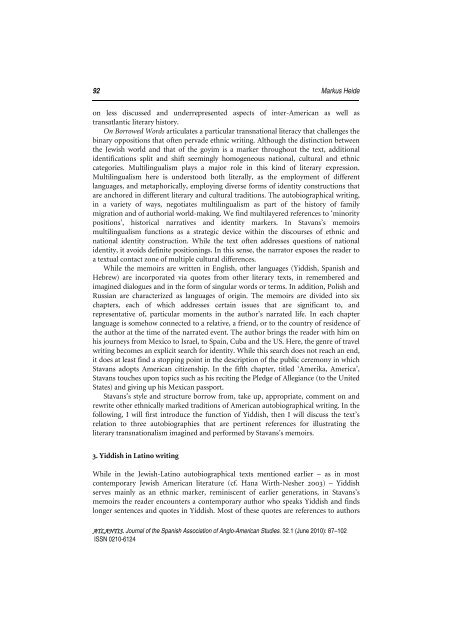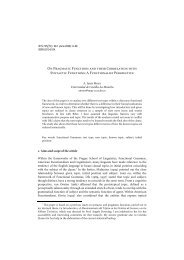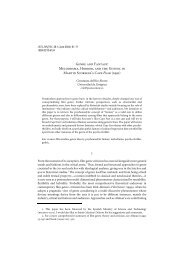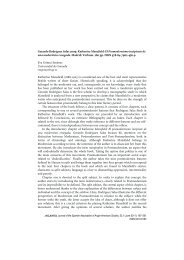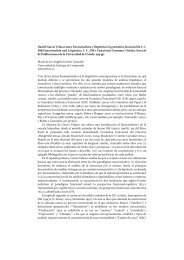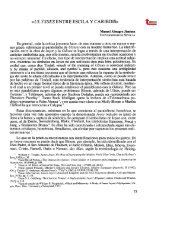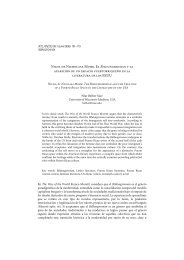Revista de la Asociación Española de Estudios Anglo - Atlantis
Revista de la Asociación Española de Estudios Anglo - Atlantis
Revista de la Asociación Española de Estudios Anglo - Atlantis
Create successful ePaper yourself
Turn your PDF publications into a flip-book with our unique Google optimized e-Paper software.
92 Markus Hei<strong>de</strong><br />
on less discussed and un<strong>de</strong>rrepresented aspects of inter-American as well as<br />
transat<strong>la</strong>ntic literary history.<br />
On Borrowed Words articu<strong>la</strong>tes a particu<strong>la</strong>r transnational literacy that challenges the<br />
binary oppositions that often perva<strong>de</strong> ethnic writing. Although the distinction between<br />
the Jewish world and that of the goyim is a marker throughout the text, additional<br />
i<strong>de</strong>ntifications split and shift seemingly homogeneous national, cultural and ethnic<br />
categories. Multilingualism p<strong>la</strong>ys a major role in this kind of literary expression.<br />
Multilingualism here is un<strong>de</strong>rstood both literally, as the employment of different<br />
<strong>la</strong>nguages, and metaphorically, employing diverse forms of i<strong>de</strong>ntity constructions that<br />
are anchored in different literary and cultural traditions. The autobiographical writing,<br />
in a variety of ways, negotiates multilingualism as part of the history of family<br />
migration and of authorial world-making. We find multi<strong>la</strong>yered references to ‘minority<br />
positions’, historical narratives and i<strong>de</strong>ntity markers. In Stavans’s memoirs<br />
multilingualism functions as a strategic <strong>de</strong>vice within the discourses of ethnic and<br />
national i<strong>de</strong>ntity construction. While the text often addresses questions of national<br />
i<strong>de</strong>ntity, it avoids <strong>de</strong>finite positionings. In this sense, the narrator exposes the rea<strong>de</strong>r to<br />
a textual contact zone of multiple cultural differences.<br />
While the memoirs are written in English, other <strong>la</strong>nguages (Yiddish, Spanish and<br />
Hebrew) are incorporated via quotes from other literary texts, in remembered and<br />
imagined dialogues and in the form of singu<strong>la</strong>r words or terms. In addition, Polish and<br />
Russian are characterized as <strong>la</strong>nguages of origin. The memoirs are divi<strong>de</strong>d into six<br />
chapters, each of which addresses certain issues that are significant to, and<br />
representative of, particu<strong>la</strong>r moments in the author’s narrated life. In each chapter<br />
<strong>la</strong>nguage is somehow connected to a re<strong>la</strong>tive, a friend, or to the country of resi<strong>de</strong>nce of<br />
the author at the time of the narrated event. The author brings the rea<strong>de</strong>r with him on<br />
his journeys from Mexico to Israel, to Spain, Cuba and the US. Here, the genre of travel<br />
writing becomes an explicit search for i<strong>de</strong>ntity. While this search does not reach an end,<br />
it does at least find a stopping point in the <strong>de</strong>scription of the public ceremony in which<br />
Stavans adopts American citizenship. In the fifth chapter, titled ‘Amerika, America’,<br />
Stavans touches upon topics such as his reciting the Pledge of Allegiance (to the United<br />
States) and giving up his Mexican passport.<br />
Stavans’s style and structure borrow from, take up, appropriate, comment on and<br />
rewrite other ethnically marked traditions of American autobiographical writing. In the<br />
following, I will first introduce the function of Yiddish, then I will discuss the text’s<br />
re<strong>la</strong>tion to three autobiographies that are pertinent references for illustrating the<br />
literary transnationalism imagined and performed by Stavans’s memoirs.<br />
3. Yiddish in Latino writing<br />
While in the Jewish-Latino autobiographical texts mentioned earlier – as in most<br />
contemporary Jewish American literature (cf. Hana Wirth-Nesher 2003) – Yiddish<br />
serves mainly as an ethnic marker, reminiscent of earlier generations, in Stavans’s<br />
memoirs the rea<strong>de</strong>r encounters a contemporary author who speaks Yiddish and finds<br />
longer sentences and quotes in Yiddish. Most of these quotes are references to authors<br />
ATLANTIS. Journal of the Spanish Association of <strong>Anglo</strong>-American Studies. 32.1 (June 2010): 87–102<br />
ISSN 0210-6124


